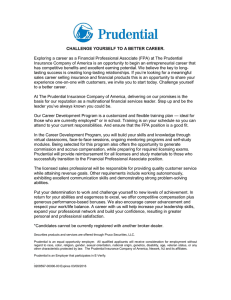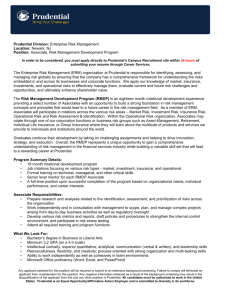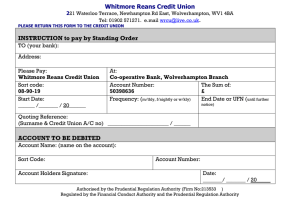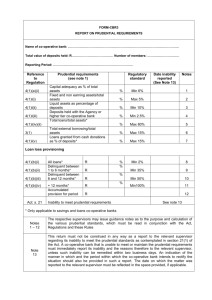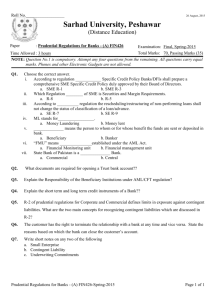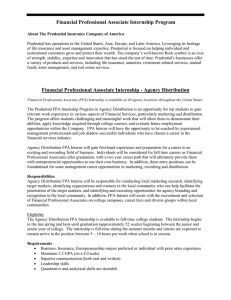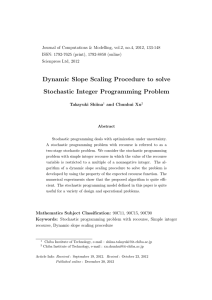Rodney Lester
advertisement
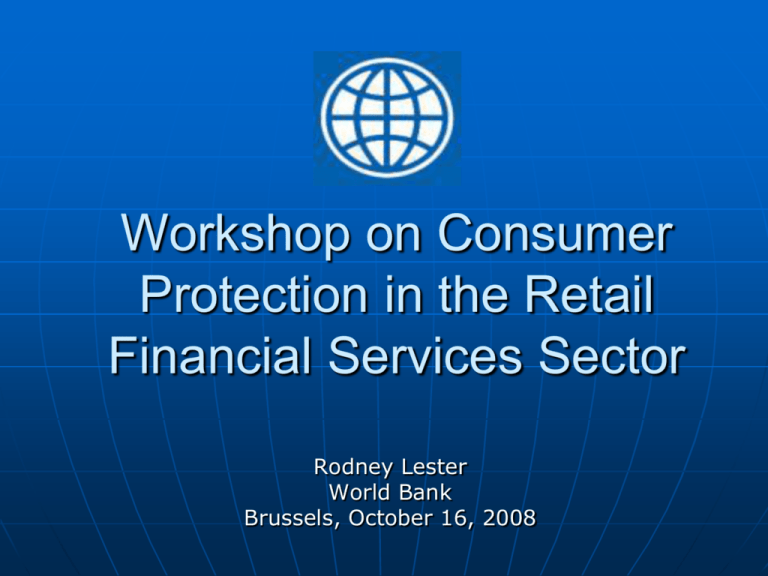
Workshop on Consumer Protection in the Retail Financial Services Sector Rodney Lester World Bank Brussels, October 16, 2008 Basic themes Main: CP regulation should be context sensitive work so far has been on reasonably similar EU accession countries Sub: • Toolkit used needs to be tailored to nature of product, stage of development of system, nature of consumer etc • Tools used should not add to consumers investment in information acquisition • Roles of prudential and CP rules should not be confused Why CP regulation? - people have to make life cycle decisions Key life events that require prior planning (in particular in democratic and market-oriented societies) ... • Children (if, when, how many, …) • Education and skills (initial, changing stream, life long learning, …) • Car, chattel purchases • Housing purchase (if, when, where, how, …) • Retirement (if, when, where, how, …) Based on: Holzmann, R. WB presentation And these all involve financial planning and decisions for 90% of people … and knowledge and skill for applying principals of economics to personal finance, e.g. •Law of one price (no free lunch) •Present value of consumption cannot exceed life time earnings •Insuring and portfolio decision under uncertainty •Budgeting and basic numeric/quantitative skills •Saving, investing, borrowing, lending, insuring, diversifying, matching, … Source: Holtzmann, R. WB presentation The Financial System is also seen to have key macro roles and positive externalities Efficient allocation of consumption, risk and investment Efficient transfer of assets/ ownership – investment becomes more secure Mobilizes savings Pricing, hedging and transferring risk efficiently – reducing cost and risk of investment Source of information – ‘coordinating decentralized decisions throughout the economy’ However an effective approach to consumer financial literacy training remains elusive So financial sector regulation has become a public good 6 possible reasons for regulation: Stop failure of financial institutions Maintain consumer confidence in the system Ensure consumers receive adequate information and are treated fairly To assure fair pricing Protect consumers from fraud and misrepresentation To prevent unfair discrimination and other social objectives * Consumer Protection as Justification for Regulating Financial-Services Firms and Products, Benston,J.B. Journal of Financial Services Research, pp 277- 301, 200 But Benston* argues only the first is justified (for banks, long term savings, 3rd party liability insurance ) and should be achieved through prudential rules 1. 2. 3. 4. 5. 6. 7. 8. Why treated differently to other products? Create moral hazard – increases risk in the system? Competition will ensure proper market conduct Most financial products are easy to understand and compare Consumers have legal recourse anyway Regulators will be conservative and over-regulate Regulation can be difficult to interpret and require ongoing modification Regulation can be used to entrench existing products and players 1. Why different? More scope for asymmetric information with credence goods * : • Akerlof – role of private information in distorting/ diminishing markets • Spence – use of signaling to overcome information asymmetries • Stiglitz - use of screening to overcome Explains information asymmetries • Presence of ‘counteracting’ market institutions * 3 types of good – search good (can be assessed in advance of purchase – piece of art), experience good (can be assessed relatively quickly with use – soap powder), credence good (attributes only discovered after a long delay or upon occurrence of contingent event or never – mutual fund). 1. Why different? - continued Managers respond to what is measured and what is rewarded: • 1946 to 1980 – technological management – the firm and its constituents counted • 1980 to now – the ‘inside proprietor’ – stock options etc – purely a value creating exercise for equity capital • More pronounced for financial sector – demutualization of life insurers, separate managers for mutual funds/ unit trusts, investment banks began ti use own capital - - all creating conflicts of interest Agency incentives more distorting: • Commission can influence product sold – not just product characteristics • Volume incentives can distort advice given CP laws are in fact in place for many experience goods • Health and safety regulations • Labeling requirements • Construction standards 3. Competition is not the full story 1960s/70s – emphasis on competition policy (market failure) – regulation of concentration, resale price maintenance, tying, information asymmetry etc Now - more complex models of markets – impact of policy interventions less clear: • No. of competitors is a poor measure • Cost of information is critical issue • Bargaining power is context sensitive (even with same skills) – e.g. role of sunk costs • One time versus frequent transactions • Cannot apply a general CP framework – depends on nature of market See: Hadfield,G.K. et al. Information-Based Principles for Rethinking Consumer Protection Policy, Journal of Consumer Policy 21, pp 131-169, 1998 3. Key questions Identifying a CP problem – identify level of competition, and whether structural or informational problem Deciding if government intervention is necessary – why is market not self correcting? Deciding on appropriate regulatory instruments – minimize information acquisition and processing costs for consumers, decide whether proactive or reactive See: Hadfield,G.K. et al. Information-Based Principles for Rethinking Consumer Protection Policy, Journal of Consumer Policy 21, pp 131-169, 1998 4. Many FS products are not easy to understand – not just annuities and life insurance 50% of those sold sub prime mortgages in the US were eligible for fixed rate loans Consumer credit wordings can see unsophisticated people lose their houses – Slovakia Bundled/ tied contracts can hide poor consumer benefits - Russia 5. Legal recourse is not cheap or easy in all countries Few countries have class action option Legal fees up front are the norm Can take many years (9 to court of first instance in Croatia) for a decision Lawyers can hide offers of settlement to draw actions out Courts can also discriminate against suppliers Courts in many emerging markets do not understand financial sector and are subject to ‘influence’. But there are legitimate concerns about MC regulation 1. 2. 3. 4. 5. Creates moral hazard – increases risk in the system? Regulators will be conservative and overregulate Regulation can be difficult to interpret and require ongoing modification Regulation can be used to entrench existing products and players – inhibit innovation CP emphasis can detract from prudential oversight Some basic criteria emerge Simple, clear - does not add to cost of consumer’s information acquisition Does not distort the market Government intervention as last resort - uses private sector mechanisms where possible Not expensive for suppliers to implement Easily accessed by the average ‘punter’ So what are the core interventions for retail FS? Capacity for cheap, efficient recourse – cooling off for complex products subject to malign incentives, ADR Make sure the consumer knows at least the basics of what they are buying – key facts documents, ratios, warning labels etc Encourage private sector information intermediaries as first option – media, rating companies, Choice etc Use prudential not CP regulation to deal with systemic risk – sub-prime, Alt- A, CDS could have been mitigated with decent capital and reporting requirements More context sensitive Deposit insurance/ guarantee funds – once in cannot remove Default products – who takes responsibility The intermediary - competent to sell the product Other contextual issues Stage of development: • LIC – minimal regulation desirable – use fit and proper • MIC – heavier reliance on recourse (ex post versus ex ante) Mandatory pensions/ insurance managed by private sector – • Use institutional structures plus g’tee funds
